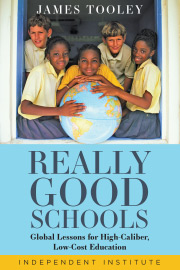Health and Higher Education
We spend about twice as much as other developed countries as a fraction of national output. Yet our results are mediocre. Public and private spending is growing much faster than our income ― putting us on a course that is clearly unsustainable. It appears we are buying quantity instead of value. Outcomes vary wildly from state to state. And programs that target the poor seem to be backfiring instead.
I’m speaking of course about…Ooops. Did you think I was describing health care? No. I’m describing our system of higher education ― making some of the same points that President Obama made the other day. Yet even the president failed to note the obvious similarities between the two fields.
Mine is the only blog site I know of that frequently compares health care and education. The problems of inner city public schools, for example, are very similar to the problems of the health care system. In both cases, the people who are supposed to benefit are different from the entity that pays the bills. In both cases, the beneficiaries are the excuse to transfer billions of dollars every year from payers to providers. In both cases, the providers and the payers argue about how much is enough, engage in an unending struggle over “reform” and blather endlessly about how dedicated they are to doing better next year.
President Obama’s solution in both fields is eerily similar. “Let’s find out what works and then go do it,” he says. What he doesn’t say is that we have been trying this strategy without success for 25 years in education. We haven’t done much better with pilot programs and demonstration projects in health care. We don’t have any difficulty pointing to centers of excellence. We seem to have an insurmountable problem replicating what we like.
Now the White House has turned its attention to higher education. If past is prologue you know what to expect: some very good analysis of the problems, coupled with an inability to focus on the real culprit: third-party payment.
But first a brief time out. What’s wrong with all the other health policy wonks? Can’t they look around their campuses and see the obvious? How can commenters go on and on year after year complaining about unsustainable trends in health care and not observe the exact same problem where they work and play? Am I the only one capable of abstraction? Or do wasteful systems look a lot better if they are the source of a paycheck? All those in academia are invited to defend themselves in the comments section.
Okay, let’s turn to some basic facts. Spending on higher education as a percent of GDP in the United States is about twice the OECD average (3.1% versus 1.5%). Yet our results are far from the top:
The U.S. once led the world in college graduates. As an example of this, Americans age 55-to-64 still lead their peers in other nations in the portion with college degrees (41 percent). But this number has flat-lined for Americans. In 2008, the same percentage of Americans age 25-to-34 and age 55-to-64 were college graduates.
Meanwhile, other nations have caught up, and some have pulled ahead. Among this younger age group, 25- to 34-year-olds, all of the following nations now have a larger percent of college graduates than the U.S.: Australia, Belgium, Canada, Denmark, France, Ireland, Israel, Japan, South Korea, Luxembourg, New Zealand, Norway, Sweden and the United Kingdom.
Our mediocre ranking is not for lack of funds. According to Richard Vedder in the Wall Street Journal on Saturday, the explosion in college costs began about the same time as the cost explosion in health care ― with the Higher Education Act of 1965:
In 1964, federal student aid was a mere $231 million. By 1981, the feds were spending $7 billion on loans alone, an amount that doubled during the 1980s and nearly tripled in each of the following two decades, and is about $105 billion today. Taxpayers now stand behind nearly $1 trillion in student loans.
And the trend is ominous. According to President Obama, over the last three decades, fees at public universities have risen 250%, compared with a 16% rise in average family incomes.
So where is all the money going? Again from Vedder:
- Princeton [University] recently built a resplendent $136 million student residence with leaded glass windows and a cavernous oak dining hall (paid for in part with a $30 million tax-deductibledonation by Hewlett-Packard CEO Meg Whitman). The dorm’s cost approaches $300,000 per bed.
- Harvard’s $31 billion endowment, financed by tax-deductible donations, may be America’s largest tax shelter.
- The University of California system employs 2,358 administrative staff in the president’s office alone.
- Since 2000, New York University has provided $90 million in loans, many of them zero-interest and forgivable, to administrators and faculty to buy houses and summer homes on Fire Island and the Hamptons.
- Former Ohio State President Gordon Gee (who resigned in June after making defamatory remarks about Catholics) earned nearly $2 million in compensation last year while living in a 9,630 square-foot Tudor mansion on a 1.3-acre estate. This Columbus Camelot includes $673,000 in art decor and a $532 shower curtain in a guest bathroom. Ohio State also paid roughly $23,000 per month for Mr. Gee’s soirees and half a million for him to travel the country on a private jet.
[Princeton? Hmm…isn’t that where Uwe Reinhardt teaches? And Paul Krugman?]
So what is all this spending doing for the students? As President Obama pointed out, the average borrower now graduates with more than $26,000 of debt, loan default rates are rising and only about half of those who start college graduate within six years. What about low-income students? We seem to be going backwards: only about 7% of recent college graduates come from the bottom-income quartile, compared with 12% in 1970 when federal aid was scarce.
Reflecting his unquenchable desire to tell everybody what to do, President Obama’s solution to all of this is top down all the way. He has already decided law school should be two years instead of three. You can think of his basic approach as pay-for-performance all over again. It didn’t work in health care, but what the hell? Why waste all the money we’ve invested in the idea without first trying it out in a few other fields.
My proposal is similar to what I’ve recommended for health care: a fixed sum voucher. Give students a bundle of money and let the colleges compete to see what they can provide for that sum. And give all the money to the students. The universities’ income will depend exclusively on how well they compete. I would also get rid of all the tax breaks for donors ― but as part of overall tax reform. The money we would save by eliminating those tax breaks is a potential new source of funds for the student voucher.
I would also insist on some pretty strict standards for the voucher. It appears that we are sending too many people to college these days. (There are 115,520 janitors in the United States with bachelor’s degrees?)
As for the pricing of the voucher, I would look carefully at fees charged for high quality, online courses. We certainly want the students to be able to afford those. Maybe we don’t have to spend much more, however. And with technological improvements, the value of the voucher may not need to increase over time.
When I was in school, colleges and universities performed two functions: (1) education and (2) parental guidance. The first task involved learning. The second task involved growing up, and it included restrictions on where students could live, the hours they (at least the women) could be out and about, whether they could own a car and other aspects of behavior. Fraternities, sororities, social clubs ― all were regulated (and strictly so) by the colleges. The schools operated under the doctrine of in loco parentis. There may be still a role for college as parent in the modern age. If so, I would let the parents pay for that. Restrict public subsidies to education alone.
[Cross-posted at Psychology Today and John Goodman’s Health Policy Blog]


















